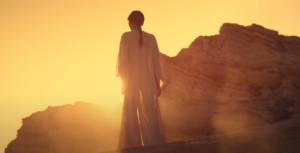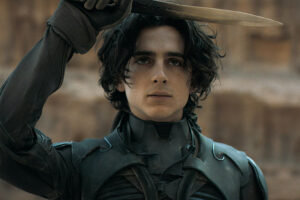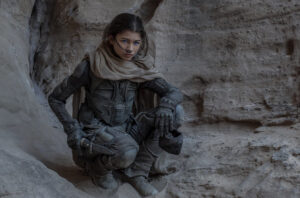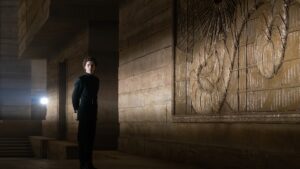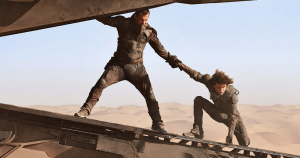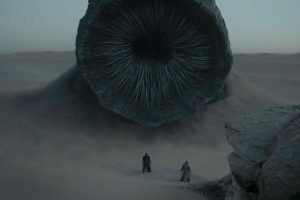The massive success of Denis Villeneuve’s brutally austere sci-fi epic Dune made Paul Atreides a household name and put the desert planet of Arrakis on the map, something that no previous adaptation of Frank Herbert’s esoteric 1965 novel has managed to accomplish, so it should come as no surprise that Paul and his supporting cast of vaguely-characterized yet vividly real allies and antagonists will be returning to movie theaters later this year for Dune: Part Two, the middle-chapter of a planned trilogy (augmented by television spin-offs) that ought to ultimately surpass Peter Jackson’s The Lord Of The Rings in terms of scale – although something tells me that even Villeneuve will have a hard time convincing general audiences and many critics that capping off his trilogy with an adaptation of Dune Messiah, the first of Dune‘s increasingly bizarre sequels, was a smart move.

Dune: Part Two, on the other hand, is a box-office hit just waiting to happen, and it’s not just because Zendaya will actually have screentime in this one. Assuming it stays fairly close to the source material (and my understanding is that Villeneuve doesn’t have any intention of diverging greatly from the narrative), Dune: Part Two will contain all the plot-beats expected of a finale, including a battle unlikely to be dwarfed anytime soon that most people looking no further than the book’s synopsis on Wikipedia would tell you is the culmination of the story’s driving conflict; the showdown between Paul Atreides and his father’s killer, Baron Vladimir Harkonnen of House Harkonnen. So I have no doubt that the vast majority of people leaving the theater come November 3rd will feel satisfied with what they will mistakenly perceive as the natural “ending” to the series, and that when they inevitably ask for spin-offs, what they won’t have in mind is what Frank Herbert wrote into Dune Messiah, a book that acts as a gatekeeper, denying most readers access to the rest of the series. My dim recollection is that I only made it through by page-skimming (I’m not proud of it, okay), and then I gave up less than halfway through Children Of Dune.
But Villeneuve’s Dune Messiah is still a long way away, and between then and now those of us who have read the books (or in my case, just enough of the books to say I tried, and little enough to prove I wasn’t a fan) will have plenty of time to prepare the film-only fans in our life for what’s ahead. In the short run it’s easy enough, deceptively easy, for anyone and everyone who watched Dune to predict where Dune: Part Two is headed, which is all to the film’s benefit. As you may remember, Dune ended with the remnants of House Atreides, a clique of conventionally attractive colonizers, scattered far-and-wide across the hostile deserts of Arrakis, which would be a fair and fitting ending to them all if only their successors weren’t the Harkonnens, an even worse bunch. But even in exile, Paul Atreides and his mother Jessica still think like colonizers. By choosing to hide amongst Arrakis’ indigenous people, the Fremen, Paul and Jessica are all but forcing them to choose a side in the coming war between the two Houses, though neither side is particularly concerned with what happens to the planet, much less the Fremen, as long as they come out on top.
As we see in the trailer, the Harkonnens have an obvious advantage when it comes to military might and the sheer amount of resources at their disposal. Crucially, they now control the flow of spice, a precious substance only found in the sands of Arrakis that enables space-travel and gives the planet its unparalleled value to the rest of the Known Universe, compelling the Emperor himself to kneel before its merchants. But Paul’s got something they haven’t got. Paul has worms.
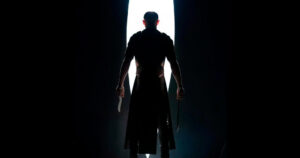
Let me rephrase that. Paul has giant worms. Nope, still not working. Paul has giant sandworms. Better? Better. The giant sandworms that slither deep beneath the surface of Arrakis, producing spice, are at the center of the intricate spider-web that is Dune‘s mythology, and learning how to ride them and communicate with them as the Fremen do is a transformative event in Paul Atreides’ life. My possibly controversial opinion about the sandworms is that no adaptation of Dune, neither Villeneuve’s nor Lynch’s, has ever successfully conveyed the staggering sense of enormity, grandeur, and mystery that accompanies every appearance of the sandworms in Frank Herbert’s novel, which has always disappointed the child in me who first read Dune (back when I was far too young to truly understand the book) solely for the sandworms, and who’s waited a long time to feel all those sensations again upon seeing them erupt from the sand. I don’t know if Villeneuve’s sandworms are too small, or too crusty-looking, or if I just dislike their design, but they remain the most underwhelming aspect of an otherwise stunning film.
Everything else on his Arrakis, everything man-made at least, is massive and majestic, from the sand-encrusted ziggurats that scrape against the heavens to the donut-shaped starships that transcend them. We see plenty more of that aesthetically distinct, Oscar-winning production design on display in the trailer for Dune: Part Two, and with so many new worlds and new areas of Arrakis to visit in the sequel it’s very likely that the team headed up by Patrice Vermette will find themselves nominated once more, alongside costume designers Jacqueline West and Bob Morgan, who have compiled a bleakly elegant wardrobe of prickly metallic gowns and headdresses for Florence Pugh’s Princess Irulan, a minor character in the first book, excerpts of whose writing are quoted by the author as if they were historical sources. Austin Butler, inexplicably wearing a bald-cap and painted blindingly-white for the role of Feyd-Rautha, is a slightly tougher sell, but that’s just another example of Villeneuve’s style and my mental image not perfectly aligning.
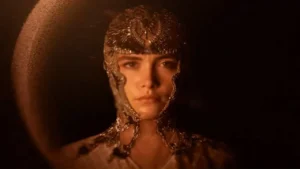
But all quibbles aside, I’m excited to return to Arrakis, and now I want to hear your takes on the trailer, the new characters introduced, and the future of the franchise after Dune: Part Two. How far into the series can Villeneuve make it before mainstream audiences give up? Share your own thoughts, theories, and opinions, in the comments below!
Trailer Rating: 8/10


